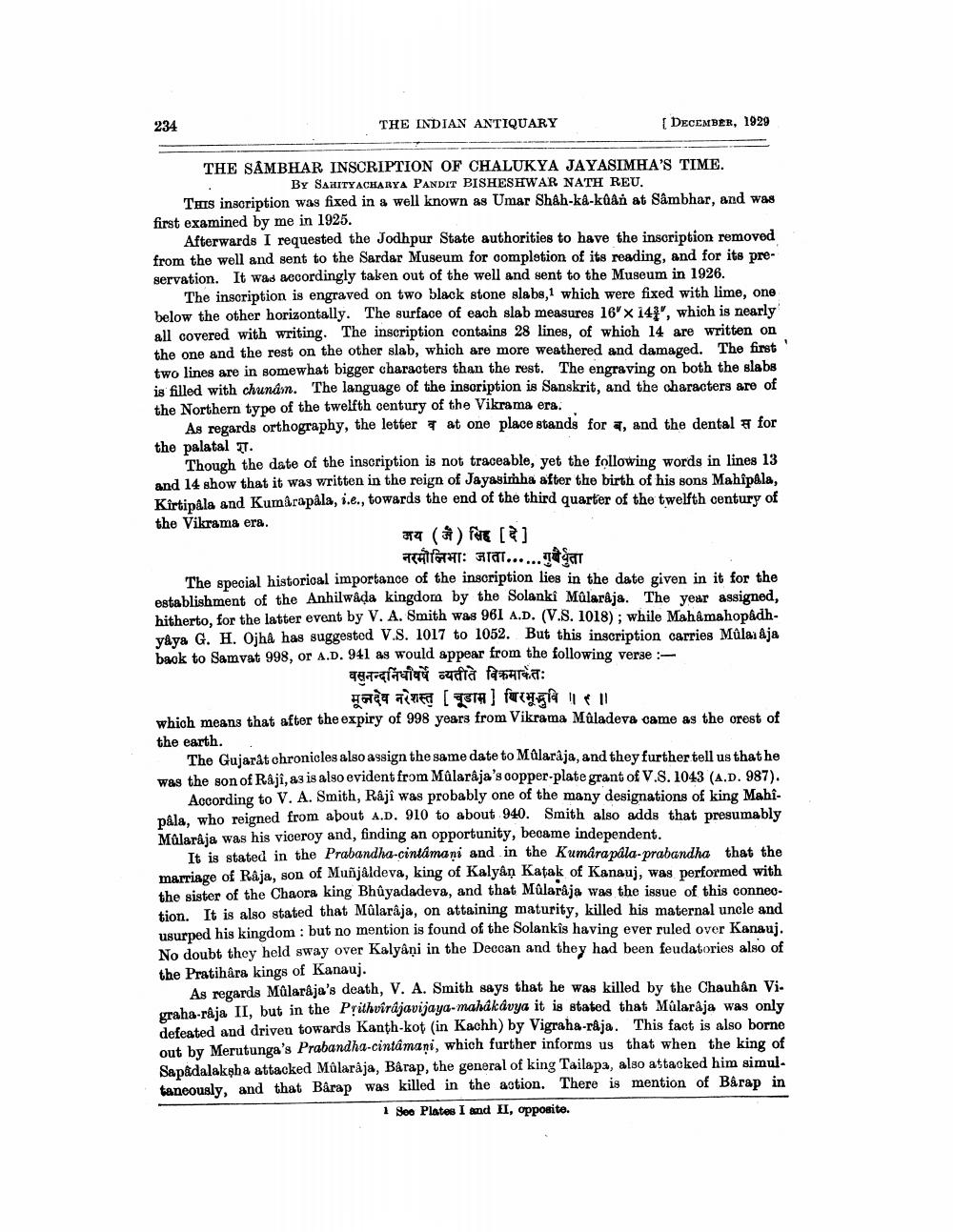________________
234
THE INDIAN ANTIQUARY
[ DECEMBER, 1929
THE SAMBHAR INSCRIPTION OF CHALUKYA JAYASIMHA'S TIME.
BY SAUITYACHARYA PANDIT BISHESHWAR NATH REU. This inscription was fixed in a well known as Umar Shah-ka-kaan at Sambhar, and was first examined by me in 1925.
Afterwards I requested the Jodhpur State authorities to have the inscription removed from the well and sent to the Sardar Museum for completion of its reading, and for its preservation. It was accordingly taken out of the well and sent to the Museum in 1926.
The inscription is engraved on two black stone slabs, 1 which were fixed with lime, one below the other horizontally. The surface of each slab measures 16" x 141", which is nearly all covered with writing. The inscription contains 28 lines, of which 14 are written on the one and the rest on the other slab, which are more weathered and damaged. The first two lines are in somewhat bigger characters than the rest. The engraving on both the slabs is filled with chunám. The language of the inscription is Sanskrit, and the characters are of the Northern type of the twelfth century of the Vikrama era.
As regards orthography, the letter at one place stands for a, and the dental for the palatal T.
Though the date of the inscription is not traceable, yet the following words in lines 13 and 14 show that it was written in the reign of Jayasimha after the birth of his sons Mahipala, Kirtipala and Kumarapala, i.e., towards the end of the third quarter of the twelfth century of the Vikrama era.
24 () fe []
TCHINGTH: 5al...... egat The special historical importance of the inscription lies in the date given in it for the establishment of the Anhilwada kingdor by the Solanki Mâlarâja. The year assigned. hitherto, for the latter event by V. A. Smith was 961 A.D. (V.S. 1018): while MahamahopadhvÂva G. H. Ojha has suggested V.S. 1017 to 1052. But this inscription carries Mûlai aja back to Samvat 998, or A.D. 941 as would appear from the following verae :
वसुनन्दनिधीवर्षे व्यतीते विक्रमातः
area T (TETA) furugla ! ! which means that after the expiry of 998 years from Vikrama Müladeva came as the orest of the earth.
The Gujarat chronicles also assign the same date to Mälarâja, and they further tell us that he was the son of Raji, as is also evident from Mâlarâja's oopper-plate grant of V.S. 1043 (A.D. 987).
According to V. A. Smith, Rájî was probably one of the many designations of king Mahî. pala, who reigned from about A.D. 910 to about 940. Smith also adds that presumably Malaraja was his viceroy and, finding an opportunity, became independent.
It is stated in the Prabandha-cintamani and in the Kumara påla-prabandha that the marriage of Raja, son of Muñjåldeva, king of Kalyan Katak of Kanauj, was performed with the sister of the Chaora king Bhûyadadeva, and that Mũlarâja was the issue of this conneotion. It is also stated that Mûlarâja, on attaining maturity, killed his maternal uncle and usurped his kingdom : but no mention is found of the Solankis having ever ruled over Kanauj. No doubt they held sway over Kalyani in the Deccan and they had been feudatories also of the Pratihâra kings of Kanauj.
As regards Malaraja's death, V. A. Smith says that he was killed by the Chauhan Vi. praha-raja II, but in the Prithvirajavijaya-mahákávya it is stated that Múlaraja was only defeated and driven towards Kanth-kot (in Kachh) by Vigraha-raja. This fact is also borne out by Merutunga's Prabandha-cintamani, which further informs us that when the king of Sapädalaksha attacked Mâlaraja, Barap, the general of king Tailapa, also attacked him simul. taneously, and that Barap was killed in the action. There is mention of Barap in
1 Soo Plates I and II, opposite.




